Clematis Arabella is a beautiful garden plant
The last chords of winter blizzards have long died down in the garden, and a gentle spring, shaking off the sleepy bliss from the plants, passes the baton on a warm June day. At this time, the reign begins clematis... These vines miraculously transform any landscape design decoration.
One can question the frightening glory of cultures about capricious character. If you show persistent friendliness and clearly follow the care recommendations, then clematis thank you for their violent and long flowering. Especially among the representatives of this species, clematis Arabella stands out. The variety is interesting and variable in its application.
Content:
- Features of the structure of the plant
- Acquisition of seedlings and planting
- Care Tips - Watering, Feeding and Pruning
- Diseases and pests
Features of the structure of the plant
A training variety for beginners and essential material for the ancient keepers of garden traditions. The length of the stems varies between 1.5-1.8 m, they are decorated with a scattering of flowers, supported by dark green leathery leaves. Inflorescences with a diameter of 6 to 9 cm are subdivided into two colors: blue with a violet tinge or blue with a purple bloom.
It blooms from June to October, allowing it to be used in many flower arrangements.
This also includes its undemandingness to the soil due to its well-developed root system... When using this clematis in gardening techniques, one should take into account the elevation of the shoots above the soil and its inability to cling to supports. Therefore, it is better to use clematis of the Arabella variety as a ground cover plant or as an ampelous option.
So, it will ideally coexist with roses or small-flowered shrubs. Although no one forbids putting its stems on the retaining wall, this will require some skill. The key to successful flower maintenance, properly prepared soil for settlement and timely care for clematis.
Acquisition of seedlings and planting
The choice of clematis seedlings should be approached with all seriousness. We can say that the health of the entire garden depends on the correctly purchased planting material. Viruses from a diseased plant will not only cause a lot of trouble, but can spread to other crops as well. So a meticulous and close examination of each pistil is the key to successful gardening. It is clear that cultures should only be purchased from trusted sellers, especially when it comes to online stores.
When buying, you need to focus on the following points:
- clematis rhizome and root part must be free of mechanical damage
- roots without thickening, not torn, elastic
- clematis must have at least 3 roots 12 cm each
- the presence of black spots is unacceptable
- an autumn plant is suitable if vegetative buds are visible, and a spring plant with the presence of at least 1 shoot
The place reserved for planting clematis must meet several criteria:
- wind proof
- bright or diffused light
The optimal size for the landing pit is 60X60X60. Clematis prefers loamy soils, but if you correct another type of soil by introducing the necessary elements, it will feel good in clay.The main condition for the clay layer is the creation of good drainage (the height of the drainage layer is about 10-15 cm):
- 1 layer - coarse crushed stone
- 2nd layer - fine crushed stone
- 3rd layer - ASG (sand and gravel mixture)
A good purchase for fertilizing all green folks and clematis, including goat dung. This species, combining a symbiosis of valuable fertilizer and compost... Since goat manure is sold as a deep bedding for animals. For a long winter in a warm barn, such a bedding is well overheated, and by spring it can be safely brought under flowers and trees.
Even if there is fertile soil on the site, you should tone the clematis and provide the plant with good organic feeding for the future. Mix the finished compost and manure in equal parts with the earth and put the mixture in a pit. Clematis will also benefit from additional protection in the form of an aqueous solution of a protective agent that needs to be spilled. It is better to replace the usual potassium permanganate with modern preparations, which will not only help to disinfect the earth, but also bring the elements necessary to protect the plant into the humus. Preparations for the arrival of the seedling should be carried out a few days earlier than the planting is intended. The necessary microbiological climate is formed in the ground, which will help clematis better take root in a new place.
If the day scheduled for planting does not please with a good forecast, then it is worth postponing this activity and planting a flower under conditions of a dry and clear day.
The deepening of the root collar and trunk should be done by about 5-8 cm. And during and after planting, the ground must be carefully compacted in order to avoid the appearance of "air pockets". After clematis is planted, it is worth marking a circle around the trunk with a diameter of about 80 cm and putting a layer of expanded clay, coarse sand (gravel), sawdust or bark.
Note: bark or sawdust must be from deciduous trees. If these are coniferous sawdust, then before using them as mulch or fertilizer, the material must be kept in a dry place for 3 years. This procedure is necessary, since caustic resins penetrate into the ground from fresh sawdust, thereby harming the plant and killing earthworms.
Care Tips - Watering, Feeding and Pruning
Thorough preparation means 50% success for good crop growth. The other half is timely and regular care. Watering Clematis Arabella should be carried out once a week, but if there is a strong heat, then the frequency should be increased. The settled warm water is poured out through a diffuser on a watering can or a hose along the contours of a near-stem mulched circle. This will moisturize the entire root system and the earth ball well.
Feeding clematis should be given special attention.
It takes a lot of energy to bloom and renew almost the entire terrestrial part every spring. Therefore, you should not wait until the plant depletes all the reserves laid down during planting and begins to give signals about its starvation by falling foliage and the loss of green color. Both minerals and organics are required. During the season, the plant should be fed about 4 times.
But for better digestibility, it is worth alternating the types of fertilizer:
- Minerals will provide the plant with a stable color, good development of the root system and the formation of new shoots. This procedure should be carried out in early September. It is best to add bone meal, then the culture will definitely receive the necessary phosphorus.
- In order to avoid fading both the clematis itself and its flowers, as well as dull flowering, it is imperative to include nitrogen in the diet. Seasoned bird droppings, diluted to a slurry, is introduced under the bush at the rate of 1 kg per 10 liters of water.
- Blackening of the pedicels, dropping of faded petals will prevent the addition of potassium sulfate.
- Introducing ash you can provide nitrogen and prevent soil acidification.
- Spring is a good time for surface treatment of clematis with a solution of synthetic urea.
The flowering period of clematis is reduced during the feeding of the crop. But Clematis Arabella pleases the eye all season. Therefore, it is worth applying the following scheme for fertilizing so that the plant is fed and continues to bloom. The entire portion of top dressing is divided into 4 parts and applied under the bush once a week. If clematis develops well, then the shoots will turn into beautiful stems over the summer. But for a successful wintering, it is worth making a thorough haircut for the garden handsome.
Pruning clematis. This part is basically the stumbling block between gardeners and clematis. Competent and timely pruning allows the plant to develop well, and the owner to be proud of him.
Clematis Arabella demands:
- sanitary pruning throughout the season. Dried stems, withered, but not fallen flowers, all this must be boldly, but carefully removed
- formative pruning. Thus, the shape is corrected.
- autumn pruning. It is important! Since Clematis Arabella blooms on new shoots
The length after trimming the shoot should not exceed 30 cm.
Diseases and pests
It is sad to look at how the plant, once full of life, sadly drops its leaves and withers before our eyes. So that this situation does not affect clematis, it is worth taking on board the diseases to which this flower is susceptible.
Its roots go into the soil by about a meter. It is there that harmful bacteria and fungi can wait for them. In principle, a healthy plant has strong immunity, but in order to avoid this trouble, clematis should be watered with special fertilizers that will help it resist such diseases:
- Fundazol will save you from gray rot, which can settle in rainy years.
- Ascochitis will cause brown spots and holes in the leaves. But a solution of copper sulfate will help to avoid this.
- Soda ash will get rid of powdery mildew, which will try to completely destroy clematis.
- Rust will come off the plant if you apply a 2% solution of Bordeaux liquid.
Clematis Arabella is used in the design of rockeries, retaining walls, balconies, it goes well for tamping roses, and serves as an excellent frame for some types of shrubs. This variety of clematis, although it may be smaller in comparison with its relatives, but its charm and a lot of positive aspects, make it a welcome guest on the garden plot.
More information can be found in the video:



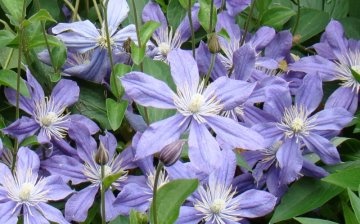
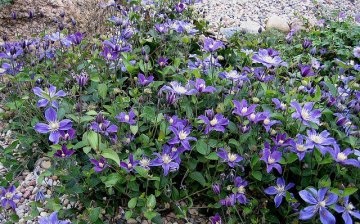
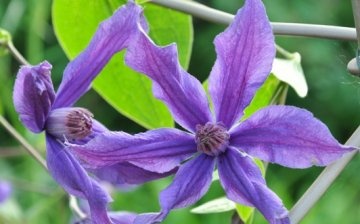
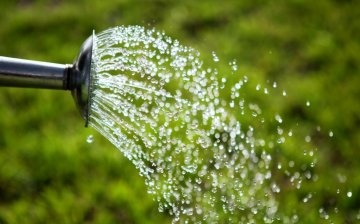






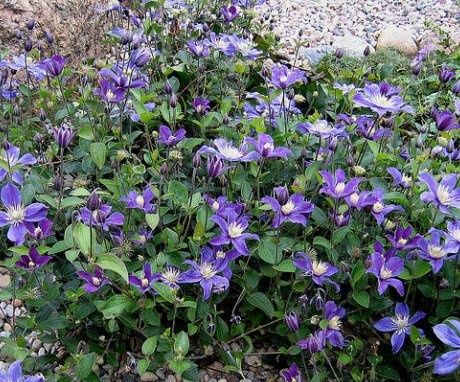
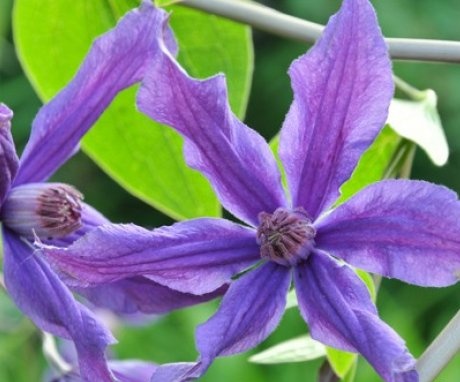
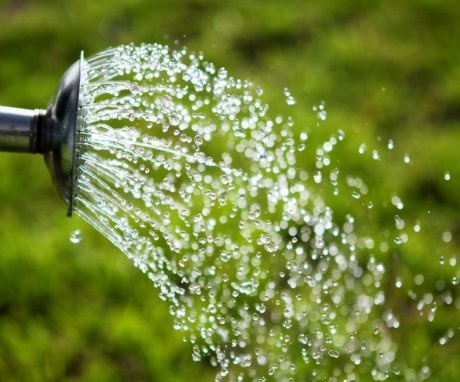
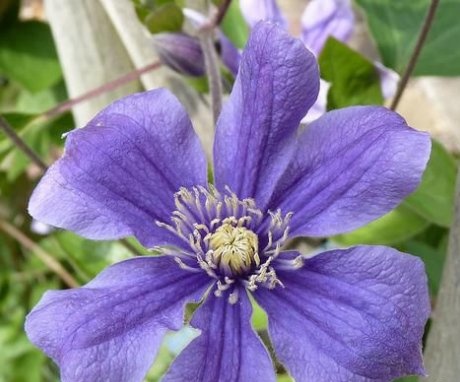
Very beautiful vine with a long flowering period. Interestingly, any soil is suitable for him, the main thing is that there is good drainage. In addition, if you plant Clematis along the fence, then all summer and September, it will be decorated with beautiful flowers.
For me, Clematis Arabella is a very capricious plant, in order to grow it you need a lot of trepidation and care. For me, it bloomed only once and then for a rather short period of time, after which it dried up.